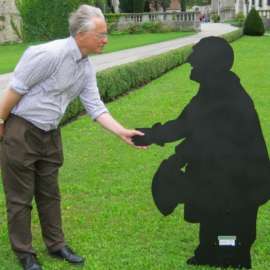This was a remarkable concert, and not merely because of the redecorated and refurbished interior of St George’s Hanover Square, nor just for the stunningly dramatic cleaned and renovated painting of The Last Supper by William Kent that loomed over us from behind the performers, but primarily for as good a performance of Haydn Op. 50/1 as you’re ever likely to hear! Somehow, right from the moment Ruth Alford (cello) set off on the repeated note motive that pervades the first movement, this was a performance of assurance, direction and heart-melting beauty, and the conversation between the players was as involving as it was delightful. All four movements were enchantingly played, but if I were to pick out one for special comment it would be the Adagio second movement. Adrian Butterfield’s (1st violin) presentation of the theme went straight to the heart, but when Katherine Parry (2nd violin) took it over whilst he provided the decoration, the subtle difference of personality demonstrated that quality of individuality subsumed within an ensemble that is part of the sheer joy of chamber music - a joy amplified when, in what was probably the fourth variation, Rachel Stott’s cello provided extraordinary demisemiquaver flourishes in the bass. As the movement finished in pianissimo repeated quavers there was a sense of Haydn’s perfection of form having been served to perfection by the performers: here in the heart of London you could have heard a pin drop.
Equally astounding had been the opening of the concert, when the slow, dissonant introduction to Mozart’s ‘Dissonance’ quartet entered the church as though from another world, ethereal, weird and very unsettling. This was no heavy late-Romantic interpretation, the Revolutionary Drawing Room perform on period instruments and are presumably ‘historically informed’, but even so this introduction was so expressively effective that it seemed to cast its disturbing shadow over the rest of the quartet, giving it a slight sobriety of utterance that never quite took flight. The contrast of Mozart’s less direct language with Haydn’s was intriguing, food for thought encouraged by Adrian Butterworth’s introduction highlighting the friendly competition between Haydn and Mozart, and how these two quartets came from sets very much part of the intercourse between the composers. This contrast was, however, slight, when compared with contrast provided by the Beethoven in the second part of the concert. There were some notable things and much that was beautiful in the performance - the presentation of the opening theme by the cello found a tone of glorious lyricism and humility, and the interplay between the always enthralling viola playing of Rachel Stott, and violins, with their descending scale figure later in the movement was captivating. To my ears the second movement’s ‘sempre scherzando’ character came off best of all. But there were times during this performance when it seemed the notes were being played because they were in the score, not with the added requirement that they were a necessary part of Beethoven’s construct; in the first movement development and later in the quartet there occasionally seemed to be a lack of direction and sometimes of sheer dramatic purpose, as though the quartet hadn’t quite got the measure of the piece. These reservations are perhaps not surprising after such a performance of the Haydn quartet: it was indeed almost as though one were listening with the ears of someone of Haydn’s time, and so it was no wonder one felt lost in the extended musical structure and Beethoven’s unruly musical gestures.
The Revolutionary Drawing Room violinists and viola play standing up, with the violins on the left, the viola to the right, and the cello sat, on this occasion, behind on a slightly raised platform. The balance was effective, though in this church acoustic maybe the cello was less forthright than we’ve become used to with modern instrument performances. Visually, they are a delight to watch, the music having an added choreographic but in no way distracting dimension. On the evidence of this concert, this is a group of performers well worth seeking out, for they play with impressive intelligence, liveliness and beauty - and if you notice they’re playing Haydn Op 50/1 again, consider cancelling your other engagements!


